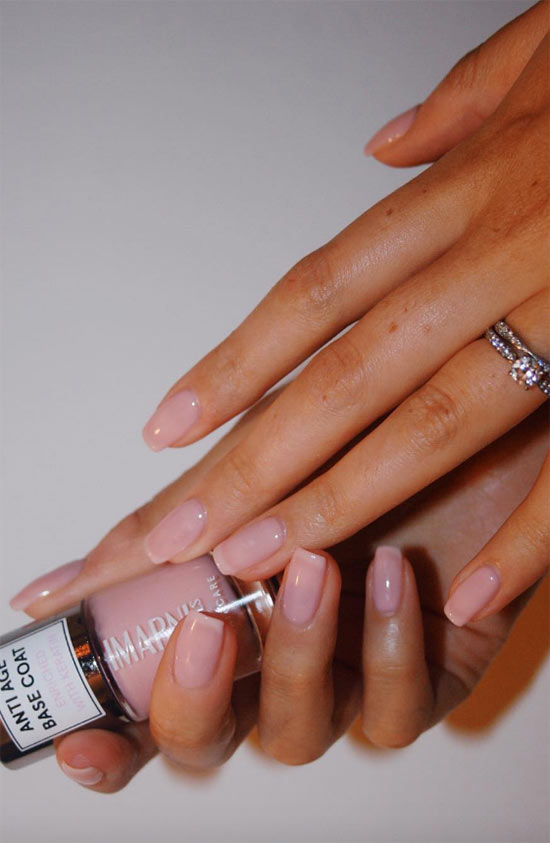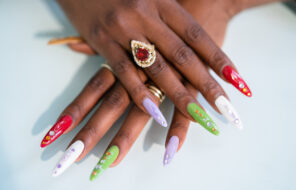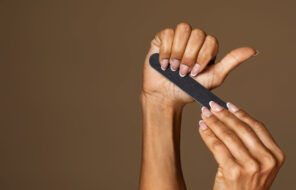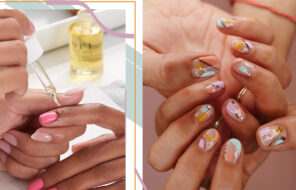Has the worst come to pass, and your nails suffered damage from a gel manicure? When done (and then removed) correctly, a gel manicure shouldn’t damage your nails. Quite the opposite – it should leave them stronger! Sadly, that doesn’t always happen. Sometimes, after removing a gel manicure, you can discover nails that are unusually thin, brittle, and worryingly breakable.
If your nails have been damaged by a gel manicure or nail extensions, we’ve got some tips to help you revive them. Even if your nails are in relatively good shape, these tips will still help you keep them strong, so you can get back into that manicure chair in no time!
Remove Your Gel Nails Correctly
As we already mentioned, incorrect nail extension removal is usually responsible for damaging the nails. If you haven’t taken off your gel manicure or extensions yet, then let us quickly summarize how to do it safely.
- First, make sure to buff off the top layer of gel.
- Then, either soak your nails in acetone or, even better, wrap them up with acetone-soaked cotton balls and some foil.
- After 12-15 minutes, take off the foil, and scrap the gel polish off with a cuticle pusher.
- If you’re dealing with extensions, use the cuticle pusher to gently slide the nail off, starting from the bottom of the nail near the cuticle.
- Finally, you can gently buff away any residue. This will get rid of the glue or gel polish without much pressure or trauma to your nails. We get into this process in a lot more detail in our article on removing nail extensions.
Take a Gel Break
Gel manicures, when done correctly, are not extremely damaging to the nails. However, if your nails are already damaged, you should give them a few weeks without more gel manicures or extensions.
Filing the nail plate is an important part of any gel manicure, but if your nails are not in decent shape from the start, it’s going to be a little too damaging. Because of that, take a break of at least a few weeks to let your nails grow and get stronger before putting them through that stress again.
Get Moisturizing
Next, you should focus on fortifying your nails, cuticles, and nail bed with moisturizing products. Any thick hand cream will work well to nourish and hydrate the skin around the nails, while a cuticle oil or cream will actually penetrate through the nail plate to fill in gaps and make your nails stronger.
Many manicurists believe that the only oil that can penetrate well through the nail plate is jojoba oil. Since we haven’t found any research to corroborate this, feel free to experiment with different cuticle oils. Some people note they see better results with thicker oils like coconut oil, for example.
The reason oils are so helpful is that once they penetrate through the nail plate, they add flexibility, which makes the nail more resistant to breaking. They also prevent water from soaking into the nail and making it more brittle.
Limit Water Exposure
Our nails absorb water easily (unfortunately, more easily than they can absorb oils), but the water isn’t particularly good for them. When saturated with water, the nails expand, and then when the water evaporates, they contract again. This weakens the bonds between the cells that make up your nails, causing them to break or peel more easily.
There are a few ways to limit water exposure, some of which we discuss in more detail throughout. In general, just try to avoid letting your nails be submerged in water for too long, including when you’re taking a bath or when you go swimming. Gloves, nail oils, and nail strengtheners can all help, as well.
Use a Nail Strengthener
A nail strengthener is usually a clear nail polish-like product that helps to create a protective layer over the nail while also infusing it with some fortifying ingredients. It keeps your nails protected from the damage of water or harsh chemicals, and it also creates a seal that will keep them from breaking. This can be especially helpful if aggressive buffing before the gel manicure has made your nails a little too thin.
Choose a great nail strengthener that’s formaldehyde-free, and made with nitrocellulose and plant proteins.

Switch to a Fortifying Polish
While taking a nail polish break is often a good idea when your nails are recovering, it might be hard to do. If you don’t want to totally give up on that bit of glam, opt for a traditional nail polish that’s enhanced by some nail-strengthening ingredients. You can actually choose a colored nail strengthener, like this version of OPI Nail Envy, but if you want more of a selection, try Orly’s breathable two-in-one Treatment + Color.
Opt for an Acetone-Free Remover
When it comes to removing extensions and gel mani, acetone is king. The rest of the time, it’s strong, drying stuff, which is why you should avoid it while trying to repair your nails. If you’re still going to be wearing regular nail polish, it’s important you remove it with a gentle, acetone-free nail polish remover, like the Londontown Kur Strengthening Lacquer Remover.
Wear Gloves
Wearing gloves regularly is one of the best things you can do to protect fragile nails. There are a ton of things out there that can damage your nails, like exposure to water, harsh chemicals, and the physical damage from working with your hands.
That’s why, for every situation, you should wear the appropriate pair of gloves. Reusable rubber gloves will protect your hands when you clean or do the dishes, work gloves will help when you do manual labor or work out in the garden, and disposable gloves are essential if you work in a salon or medical setting.
Drink More Water
Water is a real cure-all, especially since many of us are a little dehydrated without ever noticing. If your water consumption has been lacking, it’s possible that’s part of the reason why your nails have gotten easily damaged. Make sure you always have a reusable water bottle with you and drink up!
Consider a Supplement (But Carefully)
If your nails are chronically a little weak or brittle, it’s possible that the root cause is a nutritional deficiency. In that case, taking a supplement to make up for whatever is lacking in your diet will really help to strengthen your nails, and it’ll also help them recover more quickly from the damage of a gel manicure. Calcium, essential fatty acid, and B-vitamin deficiencies can all be responsible for weaker nails.
However, taking a supplement without fully understanding what you need can also have risks. B-vitamins like biotin are often recommended for stronger nails, but if you’re not deficient in them from the start, taking them likely won’t help.
Because of that, we suggest speaking to your doctor or to a certified dietitian before taking any supplements (and always tell your doctor what supplements you are taking).
Plan for Your Nails’ Future
As we mentioned earlier, gel manicures shouldn’t be particularly damaging to the nails. Incorrect removal is often the main cause of nail damage, but aggressive buffing before the manicure can also be an issue.
If you have your nails done at a salon, but you liked the results otherwise, you’ll need to let your nail technician know what happened. Tell them that they need to be gentler when it comes to pre-gel buffing, and hopefully, that will be enough.
If you don’t feel comfortable expressing this to your manicurist, you may want to switch to a salon that gets great reviews or even consider learning how to do your own gel manicure!
Photos via @imarninails, Instagram





